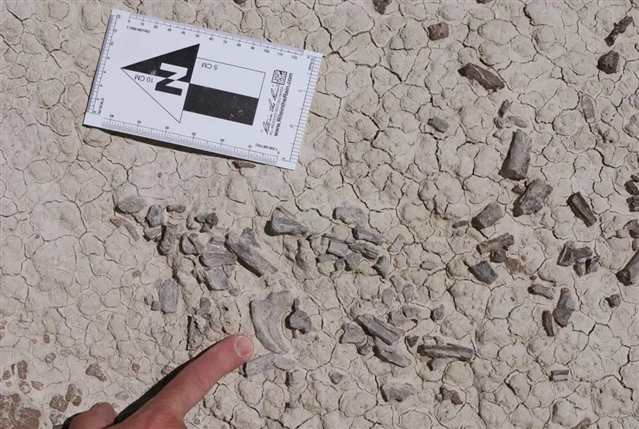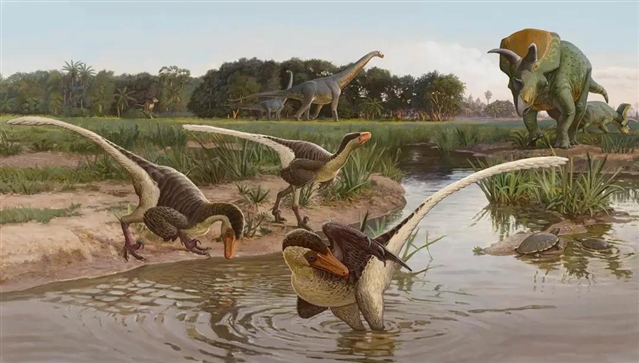|
|
|
|
|
新墨西哥州发现的新型肉食性恐龙增进了对于恐龙演化的认识 |《科学报告》 |
|
|
论文标题:New Dromaeosaurid Dinosaur (Theropoda, Dromaeosauridae) from New Mexico and Biodiversity of Dromaeosaurids at the end of the Cretaceous
期刊:Scientific Reports
作者:Steven E. Jasinski, Robert M. Sullivan et.al
发表时间:2020/03/26
数字识别码:10.1038/s41598-020-61480-7
微信链接: 点击此处阅读微信文章
本周《科学报告》发表的一篇论文New Dromaeosaurid Dinosaur (Theropoda, Dromaeosauridae) from New Mexico and Biodiversity of Dromaeosaurids at the end of the Cretaceous报告发现了一种新型驰龙,驰龙是生活在白垩纪时期的一种身覆羽毛的中小型肉食性动物。化石发现增进了我们对于白垩纪晚期(7000万-6800万年前)的恐龙演化的理解。

在Dineobellator notohesperus原始发现地,所指处是骨骼碎片中的前爪。
版权:Steven Jasinski
美国宾夕法尼亚州立博物馆的Steven Jasinski及同事在美国新墨西哥州圣胡安盆地的Ojo Alamo地层沉积物里发现了这种新型驰龙的20块可辨认骨骼碎片。该恐龙被命名为“Dineobellator notohesperus”,源自纳瓦霍语“Diné”(纳瓦霍人)和拉丁语“bellator”(勇士)。作者描述了该恐龙一系列独一无二的特征,包括靠近尾巴根部的脊椎向内弯曲,这或许能增加敏捷性,提高其捕食成功率。通过化石可以看到该恐龙巨大的镰状利爪上有一个圆凿,作者推测可能是和另一只Dineobellator或其它兽脚亚目恐龙(如霸王龙)争斗导致的。

Dineobellator notohesperus轮廓骨骼复原图。
作者和版权归属Steven Jasinski
物种关系的系统发育分析显示,Dineobellator可能属于伶盗龙亚科,其中包括伶盗龙。Dineobellator的祖先被认为从亚洲迁移到北美,可能有多支谱系在北美演化,这或许可以解释Dineobellator与其他驰龙在形态上的差异。
以上发现补充了原本稀少的驰龙化石记录,表明这一科的恐龙在白垩纪末、6550万年前非鸟类恐龙大灭绝之前,仍在发生分化。

Dineobellator notohesperus与新墨西哥白垩纪晚期Ojo Alamo组的其他恐龙的艺术复原图。
版权:Sergey Krasovskiy

Dineobellator notohesperus艺术复原图。
作者:Mary P. Williams 版权:Steven Jasinski
摘要:Dromaeosaurids (Theropoda: Dromaeosauridae), a group of dynamic, swift predators, have a sparse fossil record, particularly at the time of their extinction near the Cretaceous-Paleogene boundary. Here we report on a new dromaeosaurid, Dineobellator notohesperus, gen. and sp. nov., consisting of a partial skeleton from the Upper Cretaceous (Maastrichtian) of New Mexico, the first diagnostic dromaeosaurid to be recovered from the latest Cretaceous of the southern United States (southern Laramidia). The holotype includes elements of the skull, axial, and appendicular skeleton. The specimen reveals a host of morphologies that shed light on new behavioral attributes for these feathered dinosaurs. Unique features on its forelimbs suggest greater strength capabilities in flexion than the normal dromaeosaurid condition, in conjunction with a relatively tighter grip strength in the manual claws. Aspects of the caudal vertebrae suggest greater movement near the tail base, aiding in agility and predation. Phylogenetic analysis places Dineobellator within Velociraptorinae. Its phylogenetic position, along with that of other Maastrichtian taxa (Acheroraptor and Dakotaraptor), suggests dromaeosaurids were still diversifying at the end of the Cretaceous. Furthermore, its recovery as a second North American Maastrichtian velociraptorine suggests vicariance of North American velociraptorines after a dispersal event during the Campanian-Maastrichtian from Asia. Features of Dineobellator also imply that dromaeosaurids were active predators that occupied discrete ecological niches while living in the shadow of Tyrannosaurus rex, until the end of the dinosaurs’ reign.
(来源:科学网)
特别声明:本文转载仅仅是出于传播信息的需要,并不意味着代表本网站观点或证实其内容的真实性;如其他媒体、网站或个人从本网站转载使用,须保留本网站注明的“来源”,并自负版权等法律责任;作者如果不希望被转载或者联系转载稿费等事宜,请与我们接洽。